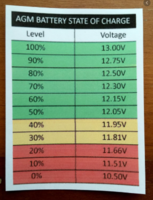Hi
@t0mb0,
thanks for taking the time to reply, very useful. Long story short on what I am try to do. Basically, I have had no end of issues with the battery / solar setup since the conversion was done back in March 2020. Its been widely acknowledged on earlier pages on this thread that it was not working correctly. The camper went back to the converter (for the second time) on 4th Jan 2021 - this time for him to fit a new panel and MPPT. However, he said he has managed to fix it all without changing the panel or the MPPT. What he said he has done is this:
1. Replaced the existing 110AH lead acid battery (which he said he had tested and was faulty), with an AGM 95AH battery
2. Replaced a cable going to the battery as he was not happy with the connector
3. Used better "bolt on" battery terminal connectors.
So, I am trying to check myself that the setup is now actually fixed, and working as it should. The pressure is on a little to test its all ok, as come Feb this year the panel and MPPT will be out of warranty. So, I want to prove to my own satisfaction that it is all working as it should before the warranties expire.
I am all ears about how I should do this. But my initial plan was to
1. test the battery independently first (forgetting about the solar), and make sure that is functioning correctly (tests above were aimed at this).
2. test that the solar panel is generating the power one would expect (for a 150W panel) in the current conditions, and charging the battery at an appropriate rate.
If I can prove the battery and solar are working ok before Feb, then I am done and I can forget about it. If I detect there is still an issue however, I need to find out quickly and get back to the converter whilst the parts are still under warranty.
Does that make sense? So I may have been going about the tests the wrong way, but thats what I am trying to achieve / prove.
On a different note. I like the idea of having something that shows the draw on the battery, I will look at your suggestions above. Something that showed it in the Victron app would be amazing. Currently I can see current going in, but cant see anything going out. Ideally, I would see something on the victron app when I turned lights on etc. What would be totally amazing, would be to see the "net amps position", i.e. if 3amps were going in from solar, but 2 were being drawn, it shows 1A charge. Not really sure whats possible. If achieving that is very expensive, then some form of clamp gauge so I can at least see load for testing would be great.
But my very short term need is to test that the battery and solar setup "post his fixes" are actually working as they should.
Many thanks.




















